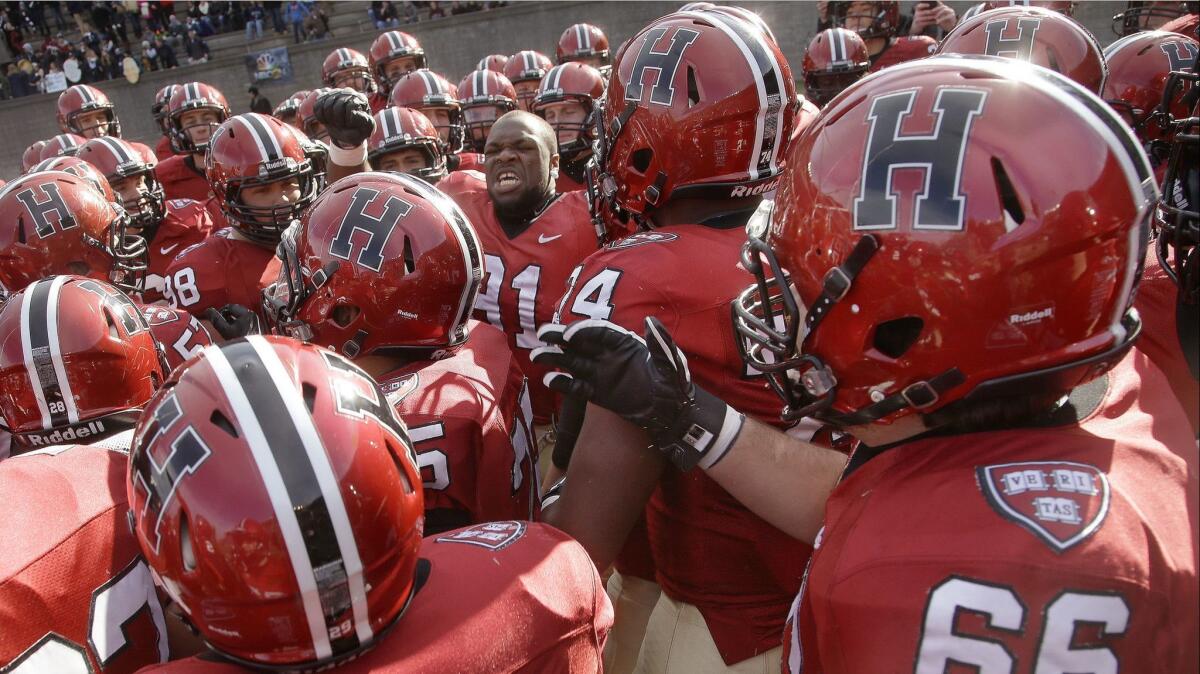Editorial: The admissions scandal revealed yet another reason to rethink college sports

- Share via
The universities caught up in the fraudulent-admissions scandal are undoubtedly looking at ways to prevent such problems in the future, focusing in many cases on their athletic departments, where coaches in soccer and water polo and other sports allegedly took bribes from wealthy parents hoping to secure admission for their children.
But the schools involved — and all colleges with hefty athletics programs — should be thinking beyond the details of the recent scandal, and examining more broadly the oversize role that varsity sports have played at U.S. institutions of higher education.
For the record:
6:45 p.m. March 24, 2019An earlier version of this editorial incorrectly stated that Notre Dame had roughly twice as many football players as Harvard.
A review is long overdue. Even two decades ago, nearly one in five slots at highly selective universities went to recruited athletes, said Jonathan R. Cole, a Columbia University professor who has studied and written about college sports. The percentage is probably slightly lower now, he said, simply because the numbers of students accepted has risen. Still, that’s a lot of recruited athletes, considering the number of academically qualified students pounding at the doors of these schools.
It’s a myth that schools will see alumni donations plummet if they cut back on varsity sports teams.
Team sports can promote school spirit and serve as an acknowledgement that some talents are physical rather than intellectual. But at some colleges, the emphasis on athletics reaches questionable levels. Cole says that Harvard’s football team has about 100 players — twice as many as on an NFL team — and Notre Dame has even more. He attributed this to a kind of mission creep at some colleges, where coaches have managed to convince administrators that they need this many players.
In addition, Harvard has 42 varsity sports teams, more than most universities, including golf, skiing, fencing and sailing. What’s more, these are the kinds of activities that tend to require private lessons and expensive equipment.
A 2016 report by the Jack Kent Cooke Foundation found that the preference given to recruited athletes gives an advantage — a further advantage — to white, wealthy students. This makes it even harder for low-income teenagers and students of color to compete for a spot in the freshman class.
At all but a handful of schools, intercollegiate sports, including football, cost more money than they bring in. And at a number of the universities where they are moneymakers, scandals have erupted over both the financial exploitation of players and illegal gifts to them.
Meanwhile, some colleges subvert their own rules to keep their teams in place. The University of North Carolina at Chapel Hill created fake classes with artificially high grades that were disproportionately “attended” by campus athletes, a fraud that went on for 18 years. Yet less than 2% of college football and basketball players will make it to the pros; they need meaningful degrees. Cole says that universities regularly recruit a large number of team members who will never actually play; they’re lesser athletes with stronger academic records whose role is to keep the team’s average grades looking good.
It’s also a myth that schools will see alumni donations plummet if they cut back on varsity sports teams. Welch Suggs, an associate professor at the University of Georgia who specializes in sports journalism, says studies don’t bear that out. Cole agrees.
Some college applicants might be drawn to schools with a lively football or basketball team and enjoy the camaraderie that comes with rooting for the team, but few people show up for sailing or fencing competitions. And at highly selective schools, students generally are drawn to a strong academic reputation rather than a winning team.
Enter the Fray: First takes on the news of the minute »
In fact, through the years, more than 150 schools have dropped their intercollegiate football teams, including about 60 Division I schools. They include selective schools such as Boston University and New York University, UC Santa Barbara and Caltech, and they don’t appear to have suffered loss of reputation or applicants as a result.
Sometimes the reason has been the expense of a losing, unpopular team. But in 2000, academic powerhouse Swarthmore College cut its football team simply because it didn’t want to allot that many of its spots to athletes. Because the school is so small, maintaining a football team meant that one in 10 male students were recruited for that one sport.
In Europe, Cole said, colleges have little to nothing in the way of intercollegiate sports, which is one way they keep costs down. Future athletes in those countries join a kind of farm-team training system that is paid for by the sports industries, not the country’s educational institutions. Right now in the United States, that sort of training system is being financed by colleges — and their students.
This isn’t to say that football and other intercollegiate sports have no place on college campuses or that talented scholar-athletes ought to become a thing of the past. But the recent scandal hasn’t just cast light on the side door to admissions that college sports programs left ajar. It should have schools examining, from the ground up, what is the right number of recruited athletes, how much money varsity sports should receive and how big that side door ought to be.
Follow the Opinion section on Twitter @latimesopinion and Facebook.
More to Read
A cure for the common opinion
Get thought-provoking perspectives with our weekly newsletter.
You may occasionally receive promotional content from the Los Angeles Times.










